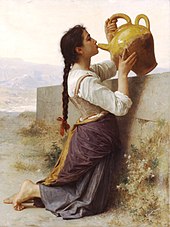Botijo
A botijo [ βoˈtixo ] (Catalan: Càntir ) is a vessel made of porous, baked clay . It has a thick, bulbous body, from the circumference of which one can infer the volume of the vessel, as well as one or more filling openings, bocas (mouthpieces), and one or more openings from which one can drink and the pitorro depending on the region ( Spout ) or pitón (croissant). This vessel is typical of Spanish culture, with each region producing a special type of botijo, which differs from the others in terms of color, shape or ceramic, etc.
Nevertheless, the principle of the botijo is always the same: The water gets through the pores of the clay to the outside and comes into contact with the dry air typical of the Mediterranean climate . The water evaporates and the resulting evaporation cold (2.219 kilojoules per gram of evaporated water) ensures that the vessel is cooled.
The fact that the Botijo can only be found in the Mediterranean climate is due to the fact that there is a relatively dry climate there in summer - in contrast to other regions with a usually humid climate at this time of the year.
Usually a new botijo is left to stand for a few hours before first use - filled with water and a dash of aniseed .
The word botijo probably comes from the Latin word buttis (bottle), later the diminutive butticula was used.
The lexicographer Sebastián de Covarrubias defined the botija in 1611 as follows: “A bulbous beaker made of clay, with a mouthpiece and a narrow neck. When the children cry and blow their cheeks, it is called 'making yourself a botija' ”.
Different traditional names exist for the botijo in many villages and regions. In the south of Andalusia, the term búcaro is more common, which, according to the Real Academia Española, comes from Mozarabic and, via this, from Latin. The products from Lebrija , a city in the province of Seville, are famous here . In Aznalcóllar , also in the province of Seville, the botijo pimporro is called.
On the occasion of traditional peasant weddings in Catalonia and Mallorca, men and women often received a càntir, a neat drinking vessel in a gender-specific design. If the couple does not understand each other in the long run or no longer, each partner can take his càntir and leave. The socio-legal background of this custom is the separation of property between men and women, which is common in Catalonia and Mallorca, in contrast to the rest of Spain.
Web links
- Museu del Cantir (cat., Span., Engl.)
Remarks
- ↑ This information about the wedding càntirs was given during a guided tour in the Museo de Vidre in Peralada on June 18, 2019 about the wedding càntirs exhibited there.


